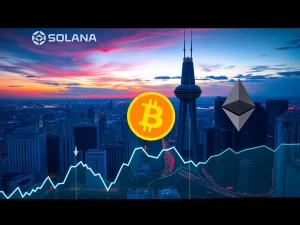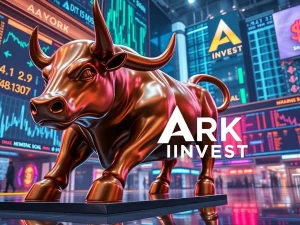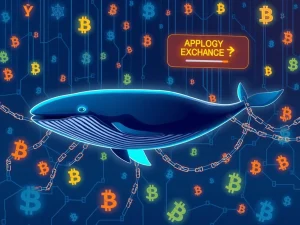Dogecoin ETF: Unveiling the Future of Cryptocurrency Speculation

The financial world recently witnessed a groundbreaking event: the launch of the first US Dogecoin ETF. This development immediately ignited a fervent debate. Is it a significant milestone for mainstream memecoin adoption, or simply the institutionalization of crypto speculation? Yohan Yun reported on this pivotal moment just minutes ago. This article delves into the core arguments, examining how this new fund impacts the broader cryptocurrency landscape and investor perceptions.
The Controversial Debut of the Dogecoin ETF
The first US Dogecoin ETF, known as Rex-Osprey Dogecoin ETF (DOJE), officially launched on Thursday. Its debut has sharply divided industry experts. Some hail it as a breakthrough, celebrating crypto’s community-driven legitimacy. Conversely, many dismiss it as mere speculation in a new, regulated wrapper. This distinction is crucial for understanding its long-term impact.
Notably, the DOJE received approval under the Investment Company Act of 1940. This framework typically applies to mutual funds and diversified ETFs. Bitcoin ETFs, for example, gained approval under the Securities Act of 1933. BlackRock’s spot crypto fund simply holds Bitcoin (BTC) in Coinbase custody. However, DOJE gains exposure differently. It uses a Cayman Islands subsidiary and derivatives. This approach aligns with the 1940 act’s requirements for diversification, restricting single-asset concentration. Therefore, its structure differs significantly from other crypto funds.
Typically, the industry celebrates new cryptocurrency ETFs. Yet, critics argue that a memecoin fund institutionalizes speculation. They also highlight the fees charged, which investors could easily avoid by buying Dogecoin directly. Furthermore, some point to the irony. Dogecoin, initially created as a joke, has leapfrogged projects with more tangible use cases to reach the ETF stage. This raises questions about market priorities.

Does the Market Truly Need a Dogecoin ETF?
Dogecoin’s origins trace back to Bitcoin. It began in 2013 as a fork of Luckycoin, itself a fork of Litecoin, which is a fork of Bitcoin. Despite its humorous start, Dogecoin grew significantly. It now ranks among the top-10 cryptocurrencies by market capitalization. Retail traders have long embraced it. Moreover, Dogecoin spawned the broader memecoin category. This category is often criticized for its casino-like nature. Consequently, its ETF approval is especially controversial. Investors can now gain exposure to Dogecoin through the stock market. However, not everyone sees the benefit.
Brian Huang, co-founder and CEO of crypto management platform Glider, voiced strong reservations. He told Crypto News Insights, “These ETFs are charging off-the-charts fees. You could simply create a Coinbase account in five minutes, buy the token, and never be charged an expense ratio.” Huang further noted that institutional investors generally prioritize “legitimate” and revenue-generating tokens. This perspective highlights a key tension in the debate over cryptocurrency ETFs.

The Challenge of DOGE Price and Tokenomics
Historically, Dogecoin has elevated some crypto investors to millionaire status. Yet, its DOGE price constantly battles inflation. Dogecoin’s tokenomics were intentionally designed as a satire of Bitcoin’s scarcity. Unlike Bitcoin’s 21-million-coin cap, Dogecoin has an unlimited supply. It issues a 10,000-DOGE block reward every minute. This means approximately 5 billion new coins are minted annually. This inflationary model stands in stark contrast to Bitcoin’s deflationary design.

During past memecoin booms, analysts frequently warned. They cautioned that such assets diverted capital and attention from more serious blockchain projects. Some observers see the Dogecoin ETF as reinforcing this problem. Douglas Colkitt, a founding contributor at layer-1 blockchain Fogo, shared his frustration with Crypto News Insights. “It’s wild to see a memecoin front-run serious projects to the ETF finish line,” he stated. Colkitt added, “An ETF wrapper doesn’t change the fundamentals; it just lets Wall Street pump DOGE with a straight face.” This sentiment underscores the ongoing debate about asset legitimacy.
Beyond Dogecoin: The Broader Landscape of Cryptocurrency ETFs
The approval of the Dogecoin ETF does not necessarily signal a free-for-all for all crypto projects. By the end of August, 92 crypto ETPs were awaiting SEC decisions in the US. Dogecoin products were among them, alongside other memecoin applications. These included Pengu, tied to the NFT brand Pudgy Penguins. Altcoin applications like XRP (XRP) and Solana (SOL) also remain in the queue. Mike Maloney, CEO and founder of Incyt, offers a different perspective. “Dogecoin may have started as a joke, but it’s become a serious altcoin,” he argued. He believes it has brought “real investors and engineers into the space.” Maloney concluded, “Community engagement is as real for a coin as it is for a stock.”

While critics like Colkitt expressed frustration, others argue differently. They suggest Dogecoin’s success reflects crypto’s unique community dynamics. Maja Vujinovic, CEO of Digital Assets at FG Nexus, told Crypto News Insights that Dogecoin leapfrogging other altcoins shows the power of communities. She believes communities can push assets into regulated structures. “If DOGE is first, it’s less about technical roadmaps,” Vujinovic explained. “It’s more about acknowledging that communities themselves can push assets into regulated structures. That’s an important signal regulators are responding to social momentum as much as market cap.” This highlights the growing influence of community in the crypto space, directly impacting memecoin adoption.
Navigating Mainstream Attention and Resilience
Unlike many altcoins, Dogecoin has frequently captured mainstream attention. Tesla CEO Elon Musk’s tweets in 2021 famously sent its DOGE price soaring. A US government department he once led was even jokingly dubbed the Department of Government Efficiency, or DOGE. The token has also weathered multiple bear markets. This resilience gives it a level of maturity that many newer memecoins lack. This sustained presence in the public eye contributes to its unique position within the market.

Vujinovic clarified that the ETF pathway will not become a “free-for-all.” She emphasized that liquidity, surveillance, and custody readiness still set high standards. “But more tokens will find their way into regulated wrappers,” she added, “which broadens adoption.” This perspective suggests a controlled expansion, not an uncontrolled rush. On Tuesday, the SEC delayed its decision on the Bitwise Dogecoin ETF. They extended the review window to November 12. This action underscores the cautious approach regulators are taking with cryptocurrency ETFs.
The Dogecoin ETF: Blurring Lines Between Meme and Market
The Dogecoin ETF compels the crypto industry to confront a fundamental question. Is embracing speculation and culture an inherent part of the package? Skeptics argue that the new fund leans too far towards the latter. For Brian Huang, wrapping a single token in an ETF is “ridiculous.” He views it as the equivalent of packaging a lone stock as a diversified product. To him, the Wall Street wrapper merely institutionalizes a meme. It also charges investors fees they could easily avoid by buying DOGE directly. This perspective highlights the ongoing tension between traditional finance and decentralized assets.
However, others counter that form holds as much importance as function. Vujinovic points out that an ETF does not alter Dogecoin’s code or purpose. Instead, it layers in crucial elements. These include custody, audits, and disclosure requirements. Such additions enhance legitimacy for mainstream investors. Douglas Colkitt sees this development as both promise and parody. If a memecoin can enter a regulated ETF, then “anything is on the table.” This could open doors for broader memecoin adoption. However, it also highlights how crypto continues to blur the line. It blends breakthrough financial innovation with pure entertainment. In this sense, DOJE doesn’t definitively answer whether memes belong in serious markets. Rather, it demonstrates that regulators and investors alike are willing to treat them as if they do.
Rex-Osprey has more memecoin ETFs in its pipeline. SEC filings outline products tied to Official Trump (TRUMP) and Bonk (BONK). Additionally, altcoins like XRP (XRP) and Solana (SOL) are also being considered. This suggests a growing trend towards expanding the range of cryptocurrency ETFs available to investors. The debate over crypto speculation versus genuine adoption will undoubtedly continue to evolve with these new offerings. The market watches closely to see how these products shape the future of digital asset investment.








